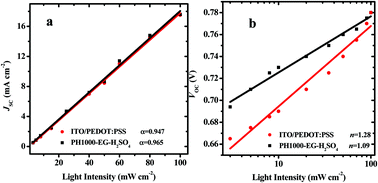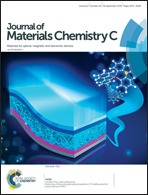Effects of highly conductive PH1000 anode in combination with ethylene glycol additive and H2SO4 immersion treatments on photovoltaic performance and photostability of polymer solar cells†
Abstract
In this study, we have fabricated efficient polymer solar cells (PSCs) by introducing a highly conductive poly(3,4-ethylene dioxy-thiophene):poly(styrene sulfonate) (PH1000) thin film treated with a combination of ethylene glycol (EG) additive and H2SO4 solution immersion as a transparent electrode (PH1000–EG–H2SO4). The conductivity and hole mobility increased rapidly as a result of the EG additive and H2SO4 solution immersion treatments and the electrical characteristics are comparable to the commercial ITO anode. The origin of enhanced conductivity and hole mobility was explored through X-ray photoelectron spectroscopy (XPS), X-ray diffraction (XRD), ultraviolet photoemission spectroscopy (UPS) and space charge limited current (SCLC) measurements. The removal of PSS from the PH1000 layer and the superior connection of the PEDOT molecule chains are the main reasons for the enhanced conductivity and hole mobility. The PH1000–EG–H2SO4-based PSCs using PH1000–EG–H2SO4 as a transparent electrode showed slightly enhanced photovoltaic performance and significantly increased photostability compared with those of the control ITO/PEDOT:PSS transparent electrode. In addition, the charge carrier recombination decreased in the interface between PH1000–EG–H2SO4 and the photoactive layer under open-circuit and short-circuit conditions, resulting in enhanced efficiency of charge carrier transport and collection.


 Please wait while we load your content...
Please wait while we load your content...